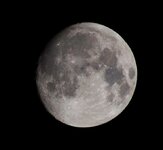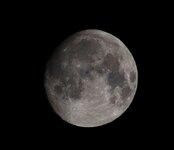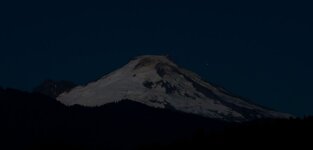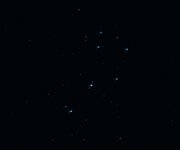DizzyDigger
Gold Member
- Dec 9, 2012
- 6,396
- 12,981
- Detector(s) used
- Nokta FoRs Gold, a Gold Cube, 2 Keene Sluices and Lord only knows how many pans....not to mention a load of other gear my wife still doesn't know about!
- Primary Interest:
- Prospecting
Been trying to get a decent Moon pic all year, so finally gave in, grabbed the
camera/tripod and headed off to a location that I used to take my telescope
to, and has a fantastic view of the night sky.
Shot these in Manual mode and manual focus, as getting a sharp pic of the
Moon where you can define structure, etc. is difficult.
Both shot at 300mm, ISO 400, f5.6 and 1/1000 sec.


Looking the other direction, I had Mount Baker glowing in the moonlight.
In this case, focus was difficult in the dark, so I took a number of shots,
manually adjusting the focus each time til I was satisfied it was as good
as it was going to get.
Shot at 97mm, ISO 800, f5.6 with a 6 second exposure.
And yes, those are stars behind the mountain..

Finally, look up saw the Pleiades (also know as "The Seven Sisters") rising to
the East. Pics of DSO's (deep space objects) are challenging, as the Earth is
rotating...and faster than you'd think! You try and take a 20 sec. exposure,
and it comes out blurred, so it requires an equatorial telescope mount that
will track the object and keep it perfectly aligned as the Earth turns. A decent
mount like that runs $1200+, and although I've had two of them in the past,
they both were sold along with the telescopes they were paired with.

camera/tripod and headed off to a location that I used to take my telescope
to, and has a fantastic view of the night sky.
Shot these in Manual mode and manual focus, as getting a sharp pic of the
Moon where you can define structure, etc. is difficult.
Both shot at 300mm, ISO 400, f5.6 and 1/1000 sec.


Looking the other direction, I had Mount Baker glowing in the moonlight.
In this case, focus was difficult in the dark, so I took a number of shots,
manually adjusting the focus each time til I was satisfied it was as good
as it was going to get.
Shot at 97mm, ISO 800, f5.6 with a 6 second exposure.
And yes, those are stars behind the mountain..


Finally, look up saw the Pleiades (also know as "The Seven Sisters") rising to
the East. Pics of DSO's (deep space objects) are challenging, as the Earth is
rotating...and faster than you'd think! You try and take a 20 sec. exposure,
and it comes out blurred, so it requires an equatorial telescope mount that
will track the object and keep it perfectly aligned as the Earth turns. A decent
mount like that runs $1200+, and although I've had two of them in the past,
they both were sold along with the telescopes they were paired with.

Last edited:








